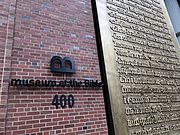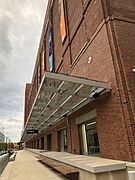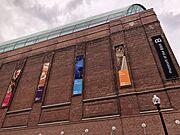Museum of the Bible facts for kids
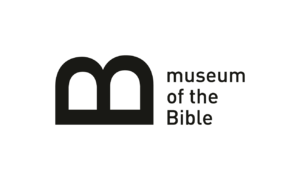 |
|
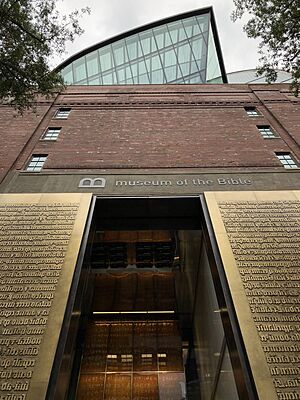
Museum of the Bible, November 4, 2017 before opening
|
|
| Lua error in Module:Location_map at line 420: attempt to index field 'wikibase' (a nil value). | |
| Established | November 17, 2017 |
|---|---|
| Location | 400 4th St SW Washington, D.C., United States |
| Type | History museum |
| Collection size | 40,000+ |
| Founder | Steve Green |
| Architect | David Greenbaum |
| Public transit access | |
The Museum of the Bible is a museum in Washington D.C., owned by Museum of the Bible, Inc., a non-profit organization established in 2010 by the Green family. The museum documents the narrative, history, and impact of the Bible. It opened on November 17, 2017, and has 1,150 items in its permanent collection and 2,000 items on loan from other institutions and collections.
Though the museum claims it is nonsectarian and "is not political, and it will not proselytize", members of the board of directors sign a "faith statement" regarding the truth of the Bible.
In the year before its launch, the museum fielded questions about the acquisition of its collection, including a federal case over smuggled Iraqi antiquities and thousands of clay artifacts, as well as the provenance of some of its exhibits. The museum's dedication ceremony received an official pontifical blessing from Pope Francis, and people in attendance included Cardinal Donald Wuerl, musician CeCe Winans, Senate Chaplain Barry Black, Washington, D.C. Mayor Muriel Bowser, and Israeli Ambassador Ron Dermer.
The Museum of the Bible charges for admission. The museum features dining, including a restaurant called Manna that serves kosher food and the Milk and Honey Café.
Contents
History
The museum was established as a nonprofit organization in 2010. The museum's building location and design were announced in 2012 when the Green family purchased the 1923 Terminal Refrigerating and Warehousing Co. building, that used to be the Washington Design Center, two blocks from the National Mall in Washington D.C. The primary donors to the museum at launch were Hobby Lobby and its owners, the Green family and the National Christian Foundation. Former museum president Cary Summers said that the goal is to "reacquaint the world with the book that helped make it, and let the visitor come to their own conclusions. ...We don't exist to tell people what to believe about it". In the initial nonprofit filling in 2010, the purpose of the museum was stated thus: "to bring to life the living word of God, to tell its compelling story of preservation, and to inspire confidence in the absolute authority and reliability of the Bible."
The estimated $400 million project updated the historically protected structure as well as adding two additional floors and a rooftop café and garden. The building's 1923 original red brick, architecture and ornamentation was restored, with new bricks imported from Denmark. The primary building was awarded historical status by the District's Historic Preservation Review Board. The glass-enclosed rooftop provides views of the United States Capitol, the Washington Monument and several Smithsonian museums. The construction efforts were led by Clark Construction. The architectural design team was led by SmithGroup.
Items from the Green Collection, which is owned by Hobby Lobby, were donated to the Museum of the Bible, providing a tax write-off to Hobby Lobby.
Exhibits
The exhibits intend to offer a scholarly perspective on the impact of the Bible in history. Bible scholar David Trobisch, former director of the museum's collections, was hired to advise on new acquisitions, identify the storylines for the museum's exhibits, and supervise a team of thirty scholars and curators. Indiana Wesleyan University professor Jerry Pattengale serves as Executive Director of Education Initiatives. The museum has an external board of advisors, and works with Jewish, Protestant, Catholic, and other religious and secular institutions.
Each of the six floors in the museum contain a different exhibit which emphasizes different aspects of the Bible's history or impact. This includes three permanent exhibit floors, each measuring 55,000 square feet (5,100 m2). The first floor combines ancient artifacts with modern technology meant to immerse the participant in the Bible. The front entrance on 4th Street SW features 40-foot (12 meter) tall, 2.5 tonnes (2,500 kg) bronze front doors with stained glass art containing a relief depicting the creation account in Genesis. There is also a grand lobby with a 140-foot (42 meter) LED ceiling allowing for changing visual effects and messages.
On the first floor, guests may experience a virtual reality tour of significant locations in the Bible, such as the Sea of Galilee or the Temple Mount. Guests will also find on this floor an exhibit displayed in partnership with the Vatican Museum and Library.
The second floor focuses on the Bible's impact on world culture, in areas like science, justice, and freedom. Another section is dedicated to the Bible's impact in American history. There is also a "flying" tour of Washington D.C. and the biblical references found within the city at some of its most notable landmarks.
The third floor presents the general narrative of the Bible from Abraham through the creation of Israel to the ministry of Jesus and the early church. This floor also contains a large Jewish Bible section.
The fourth floor presents biblical history and archaeology. Trobisch stated that the museum "will not whitewash conflicts in Christian history but will explain the arguments that were made at the time".
The fifth level contains a performing arts theater with a 500-person amphitheater. Here, the museum sponsors scholarly lectures, as well as multimedia performances relating to the Bible. Notably, the tour of the Broadway production of Amazing Grace opened at the museum's World State Theater. The fifth floor also contains separate exhibit space for displays presented by the Israel Antiquities Authority.
The sixth floor consists of a rooftop viewing area overlooking the National Mall and U.S. Capitol, stained glass exhibits, and a ballroom that seats 1,000 guests. The museum's artifact research facility and reference library is located in a one-story addition to the roof of a neighboring office complex.
Several museum partners are responsible for the design and layout of the various exhibits. The PRD Group was responsible for the history of the Bible floor. PRD Group has previously collaborated on exhibits at Smithsonian National Museum of American History and National Museum of Natural History. BRC Imagination Arts is developing the narrative of the Bible floor. Jonathan Martin Creative recreated a Nazareth village from the first century. C&G Partners led the design of the impact of the Bible floor. Previous work by C&G Partners includes the United States Holocaust Memorial Museum and the Abraham Lincoln Presidential Library and Museum.
The museum contains more than 40,000 objects and artifacts, ranging from the time of Abraham through the New Testament period. Artifacts include biblical papyri, Torah scrolls, rare printed Bibles, Jewish artifacts and contemporary treasures of Christian and Jewish culture. The museum also exhibits significant archaeological artifacts owned by collaborating institutions and private collectors such as the Israel Antiquities Authority. Steve Green has donated other ancient artifacts from his personal collection. Additional initial exhibits include remains from Julia Ward Howe's original manuscript for the famous song "The Battle Hymn of the Republic" as well as a replica of the Liberty Bell upon which is engraved the Bible verse from Leviticus "Proclaim liberty throughout all the land unto all the inhabitants thereof".
The roof of the museum features a Biblical garden, where guests can see plant varieties mentioned throughout the Bible.
Manuscript collection
The manuscript collection of the Museum of the Bible includes one of the Bodmer Papyri (3rd/4th century), the Washington Pentateuch (ca. 1000), the Hours and Psalter of Elizabeth de Bohun, Countess of Northampton (1330–1340), the Lipnice Bible (1421), a Wycliffite New Testament (first half of the 15th century), the prayer book for young Charles V (1516–1519), and many others.
Food services
"Equinox" owners and "The Jewish Table" authors Todd and Ellen Gray operate a 165-seat, Mediterranean-inspired, fine-dining restaurant inside the museum. The Grays also provide catering for events at the museum. The museum also contains a more casual lunch and coffee shop, where some of the food offerings are certified as kosher.
Opening
On Thursday, November 16, 2017, museum officials held a private opening gala and reception for the facility at the Trump International Hotel Washington D.C. in the Old Post Office Building. A single seat at the fundraising event cost $2,500, while tables cost from $25,000 to $50,000. However, a number of museum employees and academic consultants refused to enter, citing the problem of having the event in a hotel affiliated with the president of the United States, Donald Trump.
The museum opened on Friday, November 17, in a private ceremony in the museum's theater that dedicated the facility. Pope Francis sent an official pontifical blessing for the museum's dedication. According to a message from the Vatican's Cardinal Secretary of State, Pietro Parolin, who had visited Washington earlier in the week, the Pope stated that "He is confident that those who revere the sacred scriptures as the word of God will here find nourishment for their faith, while many others will be introduced to a fascinating and vital chapter in the spiritual history of the human family".
The dedication ceremony, which nearly 500 people attended, began with the hymn "Amazing Grace" sung by Gospel singer CeCe Winans. After reading Parolin's message, Cardinal Donald Wuerl, the Archbishop of Washington, offered the ceremony's opening prayer, which was followed by prayers and remarks from Chaplain of the United States Senate Barry Black, Chief of Chaplains of the United States Navy Admiral Margaret Kibben and Mayor of the District of Columbia Muriel Bowser.
Ron Dermer, the Israeli ambassador to the United States, celebrated the museum as a signifier of the Jewish claim to Jerusalem. The Bible nurtured Jews through 2,000 years of exile until they were able to "rebuild the original DC — David's Capital," Dermer said at the dedication ceremony. Yariv Levin, the Israeli Tourism Minister, read a letter from the Israeli Prime Minister Benjamin Netanyahu, who had sent "warm greetings from Jerusalem, the eternal and undivided capital of Israel". Mor Dionysius John Kawak, archbishop of the Syriac Orthodox Church and other representatives of that Oriental Orthodox denomination were in attendance at an official dinner for the museum's opening.
When the museum opened to the public on Saturday, November 18, the lines outside were short. Some exhibits bustled with visitors, while others were nearly empty and the museum was not at capacity.
Dead Sea Scrolls forgeries
Founder Steve Green donated Dead Sea Scrolls parchment fragments to the museum collection for its opening. When the museum catalog was released to the public, however, several outside experts expressed concern that the museum had not adequately accounted for the fragments' provenance. Arstein Justnes, a professor of biblical studies at the University of Agder in Norway, declared they were outright forgeries. The museum subsequently enlisted the German Federal Institute for Materials Research and Testing (Bundesanstalt für Materialforschung und Prüfung) to analyze the scrolls. The museum kept the fragments prominently on display for its official opening, while testing was still incomplete. The text of display stated that "scholars continue to debate the authenticity of this fragment". In 2018 the museum announced that expert examination had led it to conclude that five of the sixteen fragments of the Dead Sea Scrolls were forgeries and that the museum had removed them from display. According to the German researchers, those five showed "characteristics inconsistent with ancient origin". In March 2020, the museum confirmed all sixteen fragments were forgeries. The forgeries are part of a group of about 70 fragments of the Dead Sea Scrolls which came onto the market in 2002, all of which are likely forgeries.
In her article covering the opening of the museum for ABC News, Veronica Stracqualursi recounts an interview with Christopher Rollston, a professor at George Washington University specializing on the Old Testament. Stracqualursi wrote that Rollston "said he was 'particularly pleased' that the museum chose to be 'honest' about the scrolls because museums are not generally candid about artifacts potentially being forgeries."
Gallery



